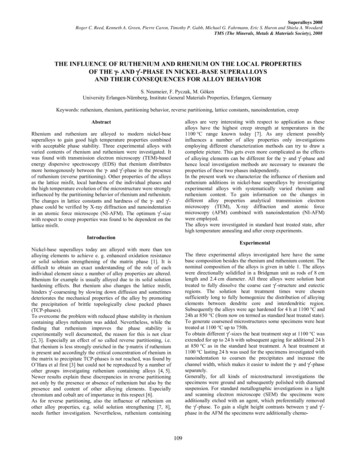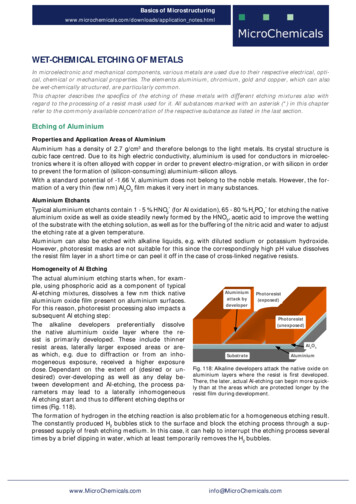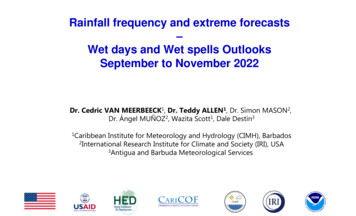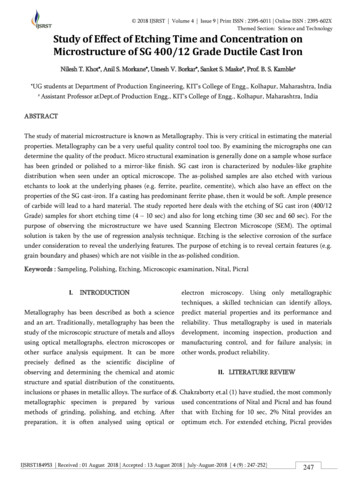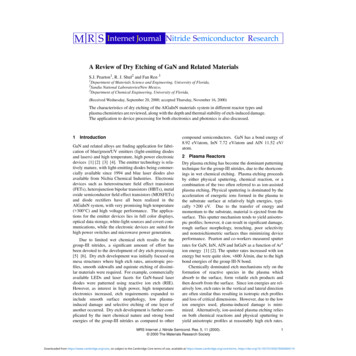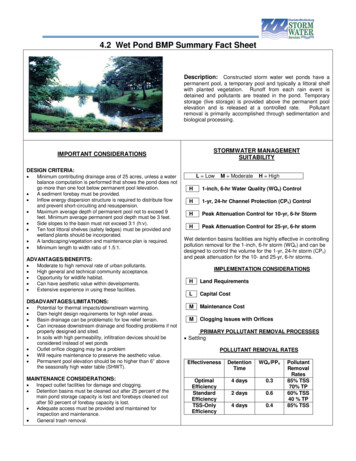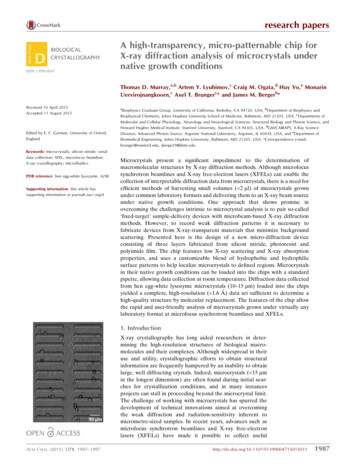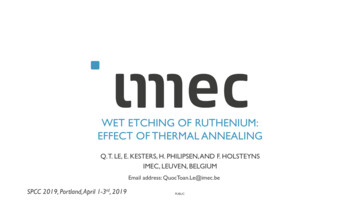
Transcription
WET ETCHING OF RUTHENIUM:EFFECT OF THERMAL ANNEALINGQ. T. LE, E. KESTERS, H. PHILIPSEN, AND F. HOLSTEYNSIMEC, LEUVEN, BELGIUMEmail address: QuocToan.Le@imec.beSPCC 2019, Portland, April 1-3rd, 2019PUBLIC
OUTLINEIntroduction to metal recess etch for Fully self-aligned via (FSAV) applicationEtching of “bulk” RutheniumEffect of annealing on blanket Ru etchingXPS and X-SEM characterizationEtching of Ru linerEffect of annealing on Ru liner etchingXPS depth profilingEtching of Ru liner using commodity chemical mixturesSummaryQ. T. Le et al., SPCC 2019, Portland, April 1-3rd, 20192
METAL RECESS ETCH FOR FULLY SELF-ALIGNED VIA (FSAV) APPLICATIONObjective: controlled recess etch of metal selectively to other materials in the stackMetalLiner/barrierDielectricBottom HMM1 CMPM1 RecessExample of metals and liner/barrier:Metal Cu; Liner/barrier Ru/ TaNMetal Ru; Barrier TaN or TiNQ. T. Le et al., SPCC 2019, Portland, April 1-3rd, 2019Metal barrier etchCo recess: A. Pacco et al., SPCC 20193
RUTHENIUM: METAL OF CHOICE FOR BEOL INTERCONNECTR [W/mm] Ru: Interconnect alternative to Cu Candidate as barrier-less metallizationfor interconnect Ru vs. Cu: Ru outperforms Cu both forline and via resistance below 12 nm CD Ru has been used as a liner layero M. van der Veen et al., IITC 2018.o H. Philipsen et al., Electrochimica Acta .093o H. Philipsen et al., Electrochimica Acta .065Line CD [nm]Q. T. Le et al., SPCC 2019, Portland, April 1-3rd, 20194
ETCHING OF “BULK” RUTHENIUM
ETCHING OF Ru USING HYPOCHLORITE SOLUTION1200As-depo. RuRu/ 300 CRu/ 420 CRs (Ohm/sq.)1000Correlation betweenRs and Ru thickness2% NaOCl800o H. Philipsen et al.,Electrochimica Acta .0656004002000050100150200250300350Immersion Time (s)See also T. Ohashi et al., SPCC 2019Q. T. Le et al., SPCC 2019, Portland, April 1-3rd, 2019 Annealing at elevated temperature (420 ºC)significantly affected Ru etch rate Annealing made the Ru film more chemical resistant Ru etch rate is inversely proportional toannealing temperature Possible mechanism Bulk change (crystallinity, grain size) Change of surface chemistry6
EFFECT OF ANNEALING ON Ru ETCH: XPSAs-deposited RuAnnealed Ru (420 C)Ru 3d C 1sO 1sO 1sReferenceReferenceO 1sO 1sC 1s2% NaOCl/ 5 min2% NaOCl/ 5 min1000800600400Ru 3d C 1sTa 4fTa 4p1200Ru 3d C 1s20001200800600400200Binding Energy (eV)Binding Energy (ev) Ta is detected for the as-depo Ru/ 5 minimmersion in NaOCl Ru was removedQ. T. Le et al., SPCC 2019, Portland, April 1-3rd, 20191000 420 C-annealed Ru was not etched in2% NaOCl/ 5 min70
EFFECT OF ANNEALING ON Ru ETCH: XPSATOMIC CONCENTRATION (At.%)OAs-depo. RuAnnealed RuCVD-Ru anneal 5 min NaOCl 53.30.629.45.65.64.554.40.6As-deposited Ru: after immersion in NaOCl solution: only a thin RuO2 layerremained at the surfaceAnnealed Ru is significantly oxidized compared to the as-deposited Ru The presence of RuO2 at the surface prevents/ slows down the etching of Ru layer afterannealingAnnealing at elevated temperature (420 C) significantly affected Ru etch rateQ. T. Le et al., SPCC 2019, Portland, April 1-3rd, 20198
XPS CHARACTERIZATION – Ru 3dAs-depo. RuAs-depo. Ru NaOCl etchAnnealed RuAnnealed Ru NaOCl etchRuIntensity (Arb. Units)Ru3d3/2288286284Ru 3dRuO2Ru3d5/2282280278Ru 3d3/2and C 1sRu 3d5/2RuIntensity (Arb. Units)Ru 3d290XPS databaseAs-depo RuAs-depo. Ru NaOCl etchAnnealed RuAnnealed Ru NaOCl etchRuO2290Binding Energy (eV)288286284282280278Binding Energy (eV) Main effect of thermal annealing: formation of oxidized Ru at thesurface The presence of Ru oxide layer is more noticeable when spectra arecollected at higher electron take-off angle (more surface sensitive)Q. T. Le et al., SPCC 2019, Portland, April 1-3rd, php
XPS CHARACTERIZATION – O 1sAs-depo. RuAs-depo. Ru NaOCl etchAnnealed RuAnnealed Ru NaOCl etchAs-depo. RuAs-depo. Ru NaOCl etchAnnealed RuAnnealed Ru NaOCl etchO 1sIntensity (Arb. Units)Intensity (Arb. Units)O 1s540538536534532530528526540Binding Energy (eV)538536534532530528Binding Energy (eV) O 1s intensity increased after annealing at 420 C Significant different spectra for surface and bulk spectra Oxidized Ru is only present at the surface In addition to RuO2, presence of other Ru with higher oxidation statesQ. T. Le et al., SPCC 2019, Portland, April 1-3rd, 201910526
Ru RECESS ETCHPatterned annealed Ru (420 ºC)Blanket annealed Ru (420 ºC)Incoming structureNaOCl - pH 12.2NaOCl-based chemistry - pH 960pH 9/ 60 sRs (Ohm/sq.)50Thicknesschange 5 nm403020100050100150200250300350Immersion Time (s)Only focused at pH 7 to avoid formation ofRuO4See for example, T. Oshahi et al., SPCC 2019Q. T. Le et al., SPCC 2019, Portland, April 1-3rd, 2019 Ru in trenches was partially etched Rougher surface vs. incoming surface Non uniform recess11
ETCHING OF RUTHENIUM LINER
Cu RECESS AND Ru LINER ETCH FLOWSHORT-LOOP STRUCTURE: Cu FILL/ Ru LINER/ TaN BARRIER1. Cu CMPCuRu Liner/barrier2 & 3. Cu recess andRu liner Etch4.TaN barrier EtchDielectricFully self-align via integrationo G. Murdoch et al., IITC 2017.o B. D. Briggs et al., IEEE IEDM 2017.Q. T. Le et al., SPCC 2019, Portland, April 1-3rd, 201913
ETCHING OF Ru LINER IN PATTERNED STRUCTURE NaOCl (2-5%) was not efficient for sidewall liner Ru removal (1-2 nm): Ru linerlayer was not etched Ru profile is very similar to N profile Possible intermixing of Ru and TaN at the interface. Possibly, formation of RuNxand/or RuTaxNy compound due to annealing. Stripping onset potential for Ru compound is different vs. metallic RuQ. T. Le et al., SPCC 2019, Portland, April 1-3rd, 201914
9 nm Cu2 nm Ru3 nm TaNSiEFFECT OF ANNEALING: XPS DEPTH PROFILES100Atomic Concentration (%)200 C/ 10 min10080O 1sCu 2pRu 3dTa 4fN 1sSi 2pC 1s6040O 1sCu 2pRu 3dTa 4fN 1sSi 2pC 1s6040200100200 400 C/ 10 min 5000050010001500Sputtering Time (s) Annealed at 400 C resulted in major difference Ru-TaN interface is much broader Formation of an intermixing and/or compoundof Ru-Ta could explain the different etchingbehavior of Ru at the interfaceQ. T. Le et al., SPCC 2019, Portland, April 1-3rd, 201915Atomic Concentration (%)Atomic Concentration (%)Reference8010001500Sputtering Time (s)80O 1sCu 2pRu 3dTa 4fN 1sSi 2p604020005001000Sputtering Time (s)1500
SURFACE ROUGHNESS AND RECESS DEPTH EVALUATIONIncoming blanket CusurfacepH 8-8.5pH 9-9.5(H2O2 0.05% HF*)4 cycles* HF with saturated DORMS 1.20 nmImmersion time 0 s1.15 nm120 s1.22 nm120 sCu line CD 20 nmIncoming Shortloop cross sectionSiO2pH 8-8.5pH 9-9.5Q. T. Le et al., SPCC 2019, Portland, April 1-3rd, 201916RMS 2.37 nm H2O2 treatmentfollowed by 0.05% HFetch: high surfaceroughness Promising results forCond. 4 and Cond. 5
SIMULTANEOUS Cu AND Ru LINER ETCH: TEM RESULTS Cu lines with CD 20 nm Estimation of Cu recess 7-9 nm Simultaneous Cu recess and Ruliner etch demonstratedQ. T. Le et al., SPCC 2019, Portland, April 1-3rd, 201917
SUMMARY
SUMMARY Thermal annealing at 420 ºC made Ru more resistant to wet etch “Bulk” Ru Presence of an oxidized Ru layer at the surface strongly affected the etch rate Annealed Ru can be etched by NaOCl-based chemistry, however it resulted in rough Rusurfaces Thin layer of Ru (Ru liner) Formation of an intermixing and/or compound at the interface could explain the differentetching behavior of Ru tuning of the etch chemicals, pH, and composition required Remark Different grain sizes different grainboundary density Surface roughness after wet etching Etch uniformityQ. T. Le et al., SPCC 2019, Portland, April 1-3rd, 201919
ACKNOWLEDGEMENTSIntegration: Chris Wilson, Gayle Murdoch, Guillaume BoccardiSurface and Interface Processing and CMP: Antoine Pacco, NancyHeylen, Katia DevriendtCharacterization (XPS, AFM, TEM, RBS): Thierry Conard, Ilse Hoflijk,Inge Vaesen, Danielle Vanhaeren, Stefanie Sergeant, Eric Vancoille, KrisPaulussen, Laura Nelissen, Hugo Bender, Johan Meersschaut, Johan DesmetQ. T. Le et al., SPCC 2019, Portland, April 1-3rd, 201920
PUBLIC
PUBLIC WET ETCHING OF RUTHENIUM: EFFECT OF THERMAL ANNEALING Q. T. LE, E. KESTERS, H. PHILIPSEN, AND F. HOLSTEYNS IMEC, LEUVEN, BELGIUM SPCC 2019, Portland, April 1 .
